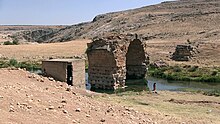Rock relief at Karasu
Coordinates: 37 ° 25 ′ 51 ″ N , 37 ° 54 ′ 30.5 ″ E
The rock relief at Karasu , also known as the rock relief of Süpürgüç after the earlier name of the nearby town Akbudak , is located on a tributary of the Euphrates and dates from the late Hittite period and shows a protective god standing on a deer.
Location and find
The rock relief is located near the village of Gümüşpınar near Akbudak in the Araban district of the Turkish province of Gaziantep , on the steep slope of a ridge that rises up to 200 meters above the Karasu , about three kilometers from its confluence with the Euphrates . The right tributary of the Euphrates has dug a deep gorge into the limestone mountains belonging to the Kartal Dağı . A few meters below the upper edge of the rock, the relief lies on the east side of a piece of rock protruding at right angles from the slope. In the early 1st millennium BC The border between the Iron Age kingdoms of Kummaḫa , which roughly corresponds to the later Kommagene , and Karkamišša ran in the area . From the inscription of the late Assyrian rock relief by Kenk Boğazı, which was ten kilometers away, which has since been destroyed , it emerges that both reliefs were still on the territory of Kummaḫa.
The relief was discovered in 1956 by geologists Krummenacher and Wilson and first described in 1958 by Charles Burney and GR Lawson.
description
A base area 1.98 meters high and 1.60 meters wide was smoothed on the boulder for the raised relief. It shows a warrior standing on a stag. The deer is 1.20 meters high, the back is 52 centimeters high and the body is 68 centimeters long. He walks to the left, his head with the slender neck raised high. On the head with the slightly open mouth, which is shown in profile, sits the finely crafted antlers shown on the front with two seven ends. According to Frank Starke , it is a fully grown red deer ( Cervus elaphus ).
Standing on the back of the animal, also walking to the left, is a male figure dressed in a short skirt and shoes, still 1.20 meters high according to today's state of preservation. She is armed with a spear in her right hand and a bow hanging over her shoulder in her left hand. In 1976 the top of the boulder was blown away by treasure hunters with dynamite. Since then, only the goatee can be seen of the head. Older pictures show details of the face and the hair tied at the nape of the neck. The warrior wore a high, round top hat from gods. The winged solar disk hovered over the figure. Even if the depiction does not include an inscription, the figure can be interpreted as a runtiya through the stag and bow . The motif "God on the deer" is from the time of the Assyrian trading posts at the beginning of the 2nd millennium BC. Known, also from the time of the Hittite empire. In the late Hittite period, for example, the motif can be found on the stele of Hacibebekli . In the area, traces of a late Hittite settlement were found during an inspection, so that it may also be the patron god of this settlement.
Hansgerd Hellenkemper and Jörg Wagner assign the work to the “traditional style” (1050–850) on the basis of stylistic elements, Winfried Orthmann dates it to the “Late Hittite II” period (950–850 BC).
bridge
About two kilometers upstream are the remains of a Roman bridge at Karasu, called Karasu Köprüsü in Turkish. It was part of the military road that led from Zeugma to Samosata and on which the monumental graves in Elif, Hisar and Hasanoğlu are to the south . From the bridge it is possible to climb to the plateau above the relief for around 45 minutes.
Web links
literature
- Charles Burney , GR Lawson: Urartian reliefs at Adilcevaz, on Lake Van, and a rock relief from the Karasu, near Birecik. In: Anatolian Studies 8, 1958, pp. 211-218.
- Hansgerd Hellenkemper , Jörg Wagner: The God on the Stag. A Late Hittite Rock-Relief on the River Karasu In: Anatolian Studies 27, 1977, pp. 167-173.
- Eberhard P. Rossner: Rock monuments in Turkey. Volume 1: The Hittite rock reliefs in Turkey. An archaeological guide. 2nd, expanded edition. Rossner, Munich 1988, ISBN 3-924390-02-9 , pp. 198-201.
- Horst Ehringhaus : The end that was a beginning. Rock reliefs and rock inscriptions of the Luwian states of Asia Minor from 12. to 8./7. Century BC Chr. Nünnerich-Asmus, Mainz 2014, ISBN 978-3-943904-67-3 , pp. 95-101.
Individual evidence
- ^ Winfried Orthmann: Investigations on late Hittite art. (= Saarbrücker Contributions to Archeology, Vol. 8) Habelt, Bonn 1971, ISBN 978-3774911222 , p. 487.





